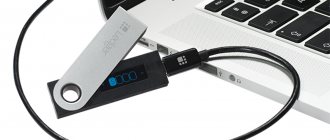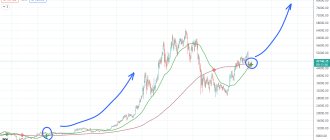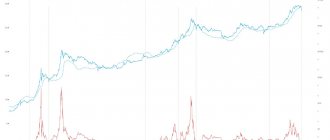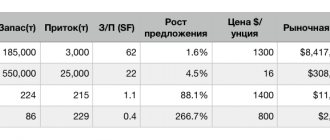The Investigative Committee of Russia was asked to check the founders of the so-called “Anti-Corruption Foundation”1 Alexei Navalny and Leonid Volkov for possible fraud. According to the applicants, the odious blogger and one of his supporters conceal information about financial transactions with Bitcoin wallets, which were created “for donations,” and appropriate part of the proceeds.
I understood the “bitcoin campaign” of FBK1 and the grounds for claims against Navalny and Volkov.
According to the publication, journalist, editor-in-chief of the Federal Investigation Agency Sergei Sokolov contacted the Investigative Committee. In his opinion, the leaders of FBK - Navalny and Volkov - hid from employees of their organization and donors information about where the funds received in cryptocurrency accounts during the “election campaign” were sent. Sokolov believes that about 41.3 million rubles could have been misappropriated this way.
It should be noted that the legal status of Bitcoin in Russia has not yet been determined. The Central Bank previously warned that transactions with cryptocurrency are high-risk, and the Supreme Court called digital currency one of the means of legalizing proceeds from crime.
Crypto campaign for a candidate
The campaign to nominate Alexei Navalny for the Russian presidential election began on December 13, 2016. On the website where funds were collected in his favor, a crypto account was indicated along with bank details.
“Prior to registering an election account, we are collecting funds for the Internet wallets of the head of the election headquarters, Leonid Volkov,” the message on the website said.
Global Look Press/Jaap Arriens
At the same time, Navalny’s team promised that it would provide “public reporting” on the receipt and expenditure of collected funds. Sergei Sokolov noted that Navalny and Volkov never fulfilled these promises.
“In FBK’s financial report for 2022, published by Alexei Navalny, the funds received by the official Bitcoin wallet are not indicated, and yet during this period more than 106 million rubles of sponsorship funds ($1.6 million) came to the cryptocurrency account. ed.),” he said in a commentary to RT.
As the publication notes, this report does not really say which funds went to bank accounts and which to crypto wallets. At the same time, in the final report on Navalny’s “election campaign” on his nomination website, it was stated that the total amount of revenue to the military-technical cooperation amounted to 91.2 million rubles. However, reporting on transactions with cryptocurrency is not indicated here either.
RT analyzed transactions on Navalny’s crypto wallets. All transactions on military-technical cooperation are anonymized, but the movement of funds can be seen in the public domain and you can find out when and what amounts were credited to accounts.
Navalny's blockchain
Unaccounted profit of several million rubles “dissolved” in the blogger’s pocket. Alexei Navalny is deceiving his supporters and withdrawing the currently popular cryptocurrency donated to him in an unknown direction. The amount of concealment has already reached several million rubles. Life.ru journalist Ilya Ukhov drew attention to the strange movements of the most popular cryptocurrency today, which is donated to blogger Alexei Navalny by his supporters, and made a powerful analytical study. Ilya analyzed transactions in two wallets of Navalny’s headquarters and compared them with official data that the blogger presents to his supporters for a report on the financing of his “presidential” campaign. It turned out that the discrepancy between official figures and the withdrawal of funds from Navalny’s Bitcoin wallets, even at the lowest rate, ranges from 1.3 to 4.8 million rubles.
And we keep wondering what kind of “shisha” Comrade Navalny and his faithful Leonid Sancho Panso Volkov are running around abroad and overseas. The scheme turned out to be simple and not complicated.
I twist, I twist, I want to confuse
What needs to be done to confuse your followers and steal money away unnoticed? You need to create several Bitcoin wallets, and then quietly replace one of them with another. No sooner said than done. Life notes that throughout the so-called “election” campaign, Navalny’s headquarters collected donations in cryptocurrency for one Bitcoin wallet. His address is listed in the donations section on Navalny’s website. But then a second wallet suddenly appeared, replacing the first, and for some reason Navalny did not publicly announce this. Ilya Ukhov writes that in the Google cache you can look at the first wallet with the hash address 3QzYvaRFY6bakFBW4YBRrzmwzTnfZcaA6E
.
But now the unique identifier of the Bitcoin wallet has changed. Now this is 3MQTRzttkMtsMEy9dRq4Sf1xiSsWKgQkyH
.
Well, who will pay attention to such significant changes during simple copying. Navalny cannot lie, he is honesty and spontaneity itself. We'll tell you. And we will continue to retell this detective story.
The last screenshot from the campaign website, writes Ilya Ukhov, with data from wallet No. 1 in the Google cache is dated October 12, 2022. It is from this day, according to the website blockchain.info, which helps track transactions of the Bitcoin blockchain, that actual payments to the new replaced wallet begin.
And this is data about the second open wallet, which now appears in the payment details of the donations section of Navalny’s website.
The change of wallet had no effect on Navalny’s followers. (However, according to
FLB’s , it is not ordinary donors who transfer bitcoins to Navalny, as he assures everyone of. This is a gray way of Western financing of the “Navalny project”)
Western curators continue to send him the cryptocurrency, which is growing by leaps and bounds. So, according to reports, at the end of October 42,465,000 rubles were received in bitcoins, at the end of November - 50,930,000 rubles, the publication writes. The report can be viewed on the website of the blogger Navalny himself. For October - here. For November here.
It turns out that in November, Navalny’s headquarters received 8,465,000 rubles in bitcoins. And the fun begins. Transactions for November show that 25.177034 bitcoins were transferred to wallet number 1, and 2.444077 bitcoins were transferred to wallet number 2. During the same period, 25.764979 bitcoins were withdrawn from wallet No. 1, and 2.593187 units of cryptocurrency were withdrawn from wallet No. 2, respectively. It turns out that a total of 27.621111 BTC was transferred to two wallets, and 28.358166 BTC was withdrawn from them.
If you take a closer look at the transactions, you can see that on November 28 at 20:44:34 an amount of 5.04702098 bitcoins was transferred to wallet No. 1, and on the morning of November 29 at 10:38:14 it was withdrawn. Based on the exchange rate that day - 2,860,267 rubles. One-room apartment in Moscow, just a minute. But that’s not even the most interesting thing. A total of 13,350,620 rubles were withdrawn from Navalny’s two wallets. This is more than the amount indicated in the official report by 4,885,620 rubles.
Life writes that the difference of almost 5 million rubles is approximate. It is very difficult to calculate it accurately due to the strong volatility of the cue ball exchange rate. Only one thing is clear: the discrepancies between the actual amount of receipts in bitcoins and those indicated in the reports amount to millions of rubles in one month. It is noteworthy that in none of the speeches, neither Alexei Navalny nor the head of his “election headquarters” Leonid Volkov say how the donations sent to them in bitcoins are doing, despite the fact that the rate of this cryptocurrency has skyrocketed. The slogan is “Navalny return the money!” can be reformulated to “Navalny return the bitcoins!”
Main wallet
The first deposit of funds was made to the wallet 3QzYvaRFY6bakFBW4YBRrzmwzTnfZcaA6E on December 8, 2016. The account received 0.0096 BTC - less than 500 rubles at the exchange rate at that time. On the day of the start of Navalny’s “election campaign,” December 13, 62 transfers were made. Moreover, these were mostly donations of small amounts.
However, the next day, December 14, an unknown person transferred 9.7 BTC to Navalny’s campaign - about 460 thousand rubles at the time of the transaction. On December 15, withdrawals of funds began in amounts of 1.5 and 9.7 BTC.
The next large amount was withdrawn from the crypto wallet on February 1. 10 BTC left the account (598 thousand rubles at the time of the transaction). Withdrawal transactions can also be seen on other days in February.
It is almost impossible to know the future fate of the cryptocurrency. RT tracked large tranches and found that they were often scattered within a few hours among dozens of other anonymous wallets and passed through a chain of “transit” wallets.
Arseniy Poyarkov, a member of the State Duma’s expert council on the digital economy and blockchain technologies, noted in a comment to the publication, perhaps we are talking about the so-called Bitcoin “mixers.” With the help of these services, hundreds of transactions from different wallets are mixed in a single pool. According to the expert, in this way the further route of funds can be hidden from the public or law enforcement agencies.
“The owner of the “mixer” takes his commission and, after mixing, sends the money to the hidden, non-public wallet of the customer. Such services are often used by criminals,” said Arseniy Poyarkov.
The publication calculated that the above-mentioned Navalny campaign wallet was replenished with 30–40 transfers every day. In total, from the moment the wallet was opened on December 8, 2016 to July 3, 2022, 2,189 transactions were made on this account. The wallet received 618 BTC (at the current exchange rate - more than 350 million rubles).
Everyone can look into Navalny's wallet. There lies 1.5 billion
Online, you can track that there are more than 1.5 billion rubles in the account, and judging by the number of transactions, an average of 450 thousand rubles comes in at a time.
Rumors about the untold wealth of opposition leader Alexei Navalny have been confirmed: Russian journalists have compiled detailed and visual instructions allowing anyone to look into the wallet where the disgraced politician stores his bitcoins.
The guide to action was announced by two presenters - Ruslan Ostashko from “Time will tell” and Anna Sochina from PolitRussia.com. According to them, the contents of Navalny’s cryptocurrency electronic wallet can be viewed in real time.
Judging by the data that is revealed if you follow the instructions, Navalny’s Headquarters has about 1.5 billion rubles. Ruslan Ostashko was shocked by this, judging by his publication on Twitter.
“We decided to check absolutely open, accessible information and went crazy. It turns out that Navalny is quite an official ruble billionaire. Even a one and a half billionaire! This is exactly the amount he received in the official Bitcoin wallet of the so-called “Navalny Headquarters,” the presenter said.
So, instructions for checking Alexei Navalny’s cryptocurrency wallet (more precisely, his “Headquarters”):
1. You need to go to the website of Navalny’s Headquarters (shtab.navalny.ru).
2. At the bottom of the page, find the “Support our work” section.
3. Select the “Bitcoin” option and copy the wallet number - 3QzYvaRFY6bakFBW4YBRrzmwzTnfZcaA6E .
4. Google “verify bitcoin wallet” and select any service - for example, blockchain.com.
5. In the e-wallet verification service, enter the copied number of the Navalny Headquarters Bitcoin wallet.
6. Select the currency “rubles”.
7. You can view your balance in real time by tracking specific transactions.
At the time of the release of the video instructions, Navalny’s Bitcoin wallet contained more than 1.5 billion rubles. Judging by the number of transactions indicated there, the amount of each transfer to Navalny’s Headquarters averaged 450 thousand rubles.
“Does this look like regular donations? The question is rhetorical. And this is just a Bitcoin wallet, but there are also standard transfers, income from a YouTube channel, and so on. Well, the fight against the authorities is a profitable business,” summed up the authors of the video.
Let us remind you that now the media and social networks are actively discussing Navalny’s latest investigation, published on YouTube after the arrest of the oppositionist and his quarantine in the Moscow pre-trial detention center “Matrosskaya Tishina”. We are talking about the “castle in Gelendzhik,” which the oppositionist calls “Putin’s palace.”
Presidential spokesman Dmitry Peskov said that the palace in the film does not belong to the head of state, and Putin does nothing there. When journalists reminded that Navalny did not claim that the head of state owned the palace directly or through his inner circle, the Kremlin representative intrigued everyone even more.
Putin himself commented on Navalny’s investigation with a phrase from Ilf and Petrov’s novel “The Twelve Chairs”: “Boring, girls.” He also stated that some of the people mentioned in the film about the palace are completely unknown to him.
Olga Lazareva
Second wallet
In the fall of 2022, the link to the first wallet from Navalny’s website disappeared. The blogger’s supporters were asked to transfer funds to another crypto account: 3MQTRzttkMtsMEy9dRq4Sf1xiSsWKgQkyH.
In just a year and a half, 72 BTC were received into this wallet - about 40 million rubles. The last large amount was credited to the account on May 10, 2018. This happened the day before Navalny was released from yet another administrative arrest. The wallet received 10 BTC, which were withdrawn the same evening.
At the same time, receipts to the first wallet also continued.
According to RT estimates, in total, from December 2016 to March 2022, about 85 million rubles were withdrawn from both wallets. At the same time, the publication notes that to calculate the amount, it used a simplified scheme: each withdrawal from wallets was counted as if these funds were cashed out instantly, and did not go through intermediary accounts and “mixers.” Each such conclusion was calculated at the ruble exchange rate on the day of the operation and summed up.
RT suggests that the report by Navalny’s team on receiving 91.2 million rubles from crypto wallets is a report on the final amount that has already been withdrawn, cashed and deposited into the campaign’s accounts.
According to Sokolov’s calculations, military-technical cooperation was transferred to the blogger in the amount of 106 million rubles. These discrepancies confirm the lack of accountability of Navalny's crypto campaign and the inability to verify the information provided by Volkov.
The head of the so-called Anti-Corruption Foundation* Alexei Navalny and his henchman Leonid Volkov can conceal information about financial transactions with Bitcoin wallets, appropriating funds transferred as donations. Information about this is already at the disposal of the Investigative Committee of the Russian Federation.
Navalny's Bitcoins will be considered by the Investigative Committee
The editor-in-chief of the Federal Investigation Agency, journalist Sergei Sokolov, submitted a statement to the Investigative Committee of the Russian Federation with a request to check the founders of the so-called Anti-Corruption Foundation Alexei Navalny and Leonid Volkov for possible fraudulent activities with cryptocurrencies. It is assumed that the leaders of FBK** hid from their donors and subordinates information about the fate of the funds received in their Bitcoin wallets during the 2018 election campaign. According to Sokolov, Volkov and Navalny could have embezzled more than 40 million rubles.
The campaign to nominate Navalny for president of Russia began in December 2016. It was then that the Navalny 20!8 website was launched, through which anyone could make a monetary donation to the blogger. A cryptocurrency account, 3QzYvaRFY6bakFBW4YBRrzmwzTnfZcaA6E, was also proposed as one of the methods for transferring funds. At the same time, the website clarified that this Bitcoin wallet belongs to Navalny’s right hand, Leonid Volkov, and public reporting will be provided on the receipt and expenditure of funds.
However, according to Sergei Sokolov, the opposition did not fulfill this promise, since the FBK financial report for 2018 does not indicate in any way the funds received by the official Bitcoin wallet. Meanwhile, during this period, funds in the amount of 106 million rubles were transferred to the cryptocurrency account. However, we can recall that Navalny’s presidential campaign formally had nothing to do with FBK, and the report on the “election campaign” on the Navalny 20!8 website states that 91.2 million rubles were received in bitcoins. However, in this case, the blogger did not provide any information about what these funds were spent on.
It is worth noting that all movements of funds on blockchain platforms are publicly available. Navalny’s accounts were no exception: any user can see when and what amounts were transferred to or withdrawn from the wallet. However, all transactions remain anonymous, which means that it is almost impossible to identify the recipients of funds.
Navalny's wallets
RT correspondents carefully analyzed all transactions involving Navalny’s crypto accounts. Thus, the first receipt to the wallet 3QzYvaRFY6bakFBW4YBRrzmwzTnfZcaA6E (hereinafter referred to as N1) occurred on December 8, 2016. 0.0096 bitcoins were transferred to the account, which at that time was less than 500 rubles. Most likely, this was the first test transaction, since after that more serious amounts began to flow into Navalny’s account.
So, on December 14, an unknown person transferred 9.7 BTC (about 460 thousand rubles) to Navalny’s campaign, and on December 15, the first withdrawals of funds began from the account: first 1 BTC, after 3.5 hours - another 5 BTC, after another five hours - 9.7 VTS. In total, during the period from December 8, 2016 to July 3, 2022, 618 BTC were credited to the N1 wallet (at the current rate - more than 350 million rubles).
At the same time, it is impossible to track the further fate of all withdrawn funds. What is known is that all large tranches were distributed among dozens of other anonymous wallets within a few hours. As Arseniy Poyarkov, a member of the State Duma expert council on the digital economy and blockchain technologies, explained, this practice makes it possible to hide the further path of money from the public or law enforcement officers, which is very popular among criminals.
In the fall of 2022, data from another wallet unexpectedly appeared on Navalny’s election website - 3MQTRzttkMtsMEy9dRq4Sf1xiSsWKgQkyH (hereinafter referred to as N2). 72 BTC (about 40 million rubles) were transferred to it in a year and a half. At the same time, in parallel with this, funds continued to flow into wallet N1. RT correspondents were able to calculate that during the election campaign, about 85 million rubles were withdrawn from both wallets. It is worth recalling that Sokolov calculated that the oppositionists received 106 million rubles worth of bitcoins. This discrepancy only speaks of the lack of accountability of Navalny’s crypto campaign.
Shadowy nature of operations
According to Sergei Sokolov, 94% of bitcoin transfers in support of Navalny’s election campaign are tranches from Western funds and organizations. Thus, the blogger was able to bypass the law on non-profit organizations in force in Russia, since the blockchain platform ensures complete anonymity of all transactions.
At the same time, an interesting pattern is revealed: large amounts of money in wallets often come from the same senders. For example, one of these addresses is 1MRgibteHt2hCXfCUrUwxTuwcJtVCWqLgc.
This wallet made nine transactions on N1 and N2 with a total amount of 32.87 BTC. Most likely, the main function of this cryptocurrency account was financial support for Navalny.
At the same time, a third of the receipts to this account were made with the participation of the address 1N52wHoVR79PMDishab2XmRHsbekCdGquK, which is marked as fraudulent on the international portal Bitcoin Who's Who.
For example, in November 2022, one of the users said that the search for 10 bitcoins stolen from him eventually led him to the address 1N52wHoVR79PMDishab2XmRHsbekCdGquK.
Of course, all this does not allow accusing Navalny and his associates of receiving fraudulent bitcoins, but it once again proves that transactions with cryptocurrencies are, as a rule, shady in nature.
In April 2022, the anonymous Telegram channel “Confession of an FBK Employee” published information that large transfers of funds to Navalny’s public Bitcoin wallets were made before the publication of each high-profile “investigation” of the FBK. For example, on November 21, 2022, 19.9 bitcoins were received into the wallet from an anonymous source, which is now equivalent to approximately 6.8 million rubles. And the next day, a video about Sergei Brilev appeared on the YouTube channel of the so-called Anti-Corruption Foundation. And the day before Navalny published an “investigation” about the chairman of the board of the Pension Fund Anton Drozdov, his account was replenished with 12.4 bitcoins (at that time - about 5.8 million rubles).
In total, Navalny received more than 62 million rubles for his “investigations,” of which, as we found out, he spent the lion’s share on his own vacation. In particular, over the past year, Alexey spent 47 million rubles on his trips to foreign resorts. So, while Navalny and his family were vacationing in Egypt, three bitcoins were withdrawn from his cryptocurrency wallet, which in our money is more than 1.3 million rubles.
Similarly, in May 2022, approximately 2.1 million rubles were withdrawn from the wallet. By lucky coincidence, it was at the same time that Navalny and his family were vacationing in Italy. The most expensive for the blogger and his family was a vacation in Thailand from January 5 to January 17, 2022. At this time, 9.9 bitcoins were withdrawn from the account, which is equivalent to an amount of 4.3 million rubles.
From the latter, one can recall Navalny’s Italian voyage. According to the anonymous Telegram channel “Corruption Money Fund,” Alexey visited the city of Rimini, where he spent a very, very decent amount of money. Thus, on June 19, 2022, the cryptocurrency wallet of the Anti-Corruption Foundation received six bitcoins (about 3.5 million rubles in accordance with the exchange rate at the time of the transaction), which were withdrawn on the same day.
And this is not the first time that Navalny has spent huge sums while on vacation in Italy. Not long ago, the blogger visited the resort town of Sorrento and was remembered by local residents for his incredible extravagance. In particular, he rented an expensive villa Villa Syrene for several days, for which he paid more than 30 thousand euros (over 2.1 million rubles).
This behavior of Navalny raises more and more questions from his associates. For example, in the regions he is increasingly accused of essentially leaving them without support, despite the fact that donations are collected specifically to help regional headquarters. In particular, a member of the FBK headquarters in Arkhangelsk and organizer of one of the actions, Alexander Peskov, was fined by the court on October 4, 2022 for participating in an unauthorized march against pension reform on September 9, 2022. However, he never received help in paying fines from the central headquarters.
* An extremist organization banned in Russia, performing the functions of a foreign agent; included in the list of extremists and terrorists on the Rosfinmonitoring website.
** An extremist organization banned in Russia, performing the functions of a foreign agent; included in the list of extremists and terrorists on the Rosfinmonitoring website
Unknown and generous “fans”
According to Sergei Sokolov, 94% of cryptocurrency transfers to Navalny’s campaign accounts are from Western funds. He came to this conclusion after analyzing more than 1,700 all incoming transactions to Volkov’s account from December 13, 2016 to March 31, 2022.
According to him, large transfers in dollar equivalent ranged from 5 thousand to 150 thousand. The remaining 6% of the transfers are small donations in the amount of 10-15 dollars.
“Due to the anonymity of transactions on the blockchain platform, theoretically, nothing could prevent foreign organizations from financing Navalny’s team, which, according to the law on NGOs, is a reason for recognizing the organization as a foreign agent,” said Sergei Sokolov.
RT discovered the following pattern: large sums in Navalny’s wallets came from the same senders. The publication identified one of the crypto accounts (conventional name - wallet X), which several times made transfers of large sums to the wallets of Navalny’s campaign.
Another interesting detail is where the funds came from to the wallet of this generous “donor.” The publication writes that almost a third of the proceeds come from the wallet 1N52wHoVR79PMDishab2XmRHsbekCdGquK (code name: wallet Y). It turned out that Y participated in six transactions, as a result of which he topped up with 29.4 BTC. And on the international portal Bitcoin Who's Who, where wallet data is analyzed, some users mark Y as fraudulent. In total, you can find dozens of fraud warnings related to this account on the Internet.
At the same time, the publication found out that X transferred bitcoins to Navalny a short period of time after receiving bitcoins from Y. The transfer amount completely coincided with the amount received from Y.
Experts suggest that wallet X may belong to a trusted person. Prospective sponsors can send bitcoins to this account as a “deposit”, and Navalny’s team will only receive them if they complete the task. This scheme is reminiscent of the work of so-called guarantor services on illegal trading platforms.
Ruslan Yusufov, managing partner of the cryptocurrency consulting company Mindsmith , said that guarantor services are common on marketplaces of illegal goods and services, which are most often posted on the darknet, but not in all cases. He added that this could not only be about Bitcoin - it could be other cryptocurrencies and regular money.
“Since the parties do not trust each other, we have to resort to the services of guarantors in order not to be deceived. This is one of the ways of self-regulation of the shadow cyber community.
Usually the guarantor is a respected and trusted person in the community (an administrator or moderator of a forum, for example),” Yusufov explained in a commentary to RT.
American LNG is rushing to take over the world
In recent years, a revolution has occurred in the treatment of stroke and doctors can effectively deal with it, said the chief neurologist of the National Medical Center. Pirogov, Doctor of Medical Sciences Oleg Vinogradov, commenting on the death of TV presenter Mikhail Zelensky. According to preliminary data, he died of a stroke.
On Wednesday, January 12, at the age of 47, journalist and presenter of VGTRK Mikhail Zelensky died. He was on vacation in the Dominican Republic, where he felt unwell. Doctors tried to save him, but the attempts were in vain. According to preliminary data, the cause of death was a stroke.
“Firstly, there are different strokes: ischemic (when a cerebral artery closes and a part of the brain dies) and hemorrhagic (when, on the contrary, a cerebral artery ruptures and blood spills into the brain substance, leading to its damage). What happened at Zelensky’s is unknown. But on average, the older patients become (over 60 years), the greater the risk of ischemic stroke. In young people, the type of hemorrhagic stroke is more common,” says Vinogradov.
In addition, the specialist continues, if Zelensky had any risk factors before traveling to the Dominican Republic (hypertension, diabetes mellitus, high cholesterol, congenital problems with cerebral arteries and others), which he did not control or correct, then the sudden change in climate could contribute to a stroke.
“When you suddenly move from cold to hot, the body adapts, including the restructuring of the immune system. There is no serious evidence base on this issue, but it is better to use the principle “from cold to cold, from hot to hot” when choosing a vacation. That is, relax at ski resorts in winter, and at sea in summer, late spring and autumn, and not expose the body to serious changes,” the doctor recommends.
He also drew attention to the fact that long flights, when a person is immobilized for a long time, as well as time zone changes are additional risk factors for stroke and generally have an adverse effect on the body.
The doctor notes that in recent years medicine has made great progress in the treatment of stroke, so he does not rule out the possibility that if Zelensky had ended up in a country where medicine was more developed, he could have been saved.
“In recent years, there has been a revolution in stroke treatment. We can effectively manage strokes, especially ischemic ones. That is, if an artery is blocked by a blood clot (ischemic stroke), then we can dissolve this blood clot by doing thrombolytic therapy, and remove it by doing thrombectomy - now the possibilities are very expanded. The only thing is that you need to seek medical help as early as possible - as soon as the first symptoms of a stroke appear. Then there is a high chance that the person will really be helped. We have patients whose arms and legs do not move, they do not speak, but after performing the procedures everything returns,” says Vinogradov.
He recalls that the first signs of a stroke can be identified using the “FAST” test - “Face-Hand-Speech”: the corner of the mouth has drooped, weakness in the arm has appeared and speech has been impaired. If such symptoms appear, you should immediately consult a doctor.
“And what is very important, a stroke is when a part of the brain has already died as a result of a vascular accident. This emergency condition, which happens here and now, develops suddenly. Therefore, you should not wait for any warning signs, but identify risk factors for stroke in advance and correct them. Hypertension, impaired lipoprotein levels (high cholesterol), diabetes mellitus, sedentary lifestyle, smoking, alcohol abuse, obesity, atrial fibrillation - these factors indicate that a person has an increased risk of stroke,” warns the neurologist.
In this regard, each person needs to actively identify these risk factors and correct them, the specialist continues. That is, look at the heart rhythm, the condition of blood vessels, and so on. All this can be revealed at an annual medical examination, which the doctor strongly recommends not to ignore or skip.
Earlier, Moscow Mayor Sergei Sobyanin, as well as the government of the Moscow region, expressed deep condolences to Zelensky’s family and colleagues.
Bitcoin investigative fees
Earlier, the Federal News Agency revealed a connection between FBK investigations and receipts to Navalny’s accounts in cryptocurrency. For example, after the release of a video on Navalny’s channel with an attack on the Minister of Culture of Russia Vladimir Medinsky and Konstantin Goloshchapov, the blogger’s account was replenished at one time by 6.8 bitcoins. In rubles, this amount will reach almost 3.5 million rubles.
This allows us to conclude that the so-called “investigation” was commissioned by a generous shadow sponsor.
Pr Scr youtube.com/
RT also compared large receipts to the blogger’s crypto accounts and publications of high-profile investigations and found many matches.
For example, on November 21, 2022, the Bitcoin wallet was replenished by 19.9 BTC (5.78 million rubles), and on November 22, information about the British citizenship of TV presenter Sergei Brilev was published. Before this, in September, 12.4 BTC (5.85 million rubles) were credited to the account. The next day, FBK published an “investigation” about the chairman of the board of the Pension Fund, Anton Drozdov.
In addition, the publication found that since April 1, 2022, a wallet with the address 3DdBZ734DjaqBf29PvjxWv9mvU6VaQEs8H regularly replenishes one of Navalny’s accounts with amounts starting from 1 BTC (about 270 thousand rubles). Enrollments coincide with the dates of broadcasts and release of videos on Navalny’s website.
Cashing out cryptocurrency
According to RT, from 2017 to 2022, cryptocurrency was legalized to finance Navalny’s campaign through the Fifth Season of the Year fund. This became known during an inspection carried out by the Ministry of Justice at the request of the Moscow prosecutor's office.
The founder of the “Fifth Season”, which was created in the spring of 2014, was Leonid Volkov. This fund rented premises for Navalny3’s headquarters in the regions and entered into agreements with employees of the blogger’s team. And in 2022, almost all of the operational activities of Navalny’s campaign were carried out through the Fifth Season accounts.
Global Look Press / Nikolay Titov / Global Look Press
At the same time, in 2022 the fund filed zero reports, and in 2018 it submitted a report according to which 164 million rubles passed through its accounts for 2022.
In January 2022, the Ministry of Justice of the Russian Federation filed an administrative claim with the Meshchansky District Court of Moscow to liquidate the fund. In court, a representative of the department said that “Fifth Time of the Year” raised funds in bitcoins, “which provides for the anonymity of transactions, while anonymous donors are prohibited from depositing money into the accounts of registered presidential candidates.”
The court decided to liquidate the fund. During the inspection, it turned out that “Fifth Time of the Year” did not accept cryptocurrency directly, but with the help of intermediaries. On cryptocurrency exchanges, bitcoins were exchanged for rubles or other currencies, the funds were cashed out, and then FBK employees or authorized representatives deposited the amounts into the Fifth Time of the Year accounts in Sberbank and Alfa Bank.
Volkov, for example, deposited 32.8 million rubles, and FBK employee Anna Chekhovich deposited 17.3 million rubles into her Alfa Bank account over the course of six months. Ruslan Shaveddinov , at that time the press secretary of Navalny’s campaign, contributed 15.5 million rubles.
Journalistic Truth
Navalny’s Bitcoin wallets, thanks to which millions of rubles are transferred to the “anti-corruption fighter,” have finally attracted the interest of law enforcement officers.
The Investigative Committee of Russia asks to conduct an inspection of the founders of the Anti-Corruption Foundation (FBK), Alexei Navalny and Leonid Volkov, for possible fraudulent activities. Reports this.
The applicants believe that Volkov and Navalny are embezzling part of the donations and concealing information about transactions with wallets.
The editor-in-chief of the Federal Investigation Agency believes that they could have embezzled about 41 million 300 thousand rubles during the 2022 election campaign.
It should be noted that Bitcoin has gained popularity precisely because it ensures the anonymity of transactions. It is not yet banned in Russia.
However, on February 26, the Supreme Court of Russia called cryptocurrencies one of the means of legalizing criminal proceeds.
So, the “Navalny 20!8” election campaign began on December 13, 2016. Then the candidate began collecting donations and published a link to a cryptocurrency account – 3QzYvaRFY6bakFBW4YBRrzmwzTnfZcaA6E.
“Prior to registering an election account, we are collecting funds for the Internet wallets of the head of the election headquarters, Leonid Volkov,” it was specified on the Navalny 20!8 website. “Public reporting will be provided on the receipt and expenditure of funds.”
However, no report to voters was forthcoming. Navalny’s financial report for 2022 does not contain information about the funds received into the Bitcoin wallet. But then 106 million rubles ($1.6 million) passed through his account.
To be fair, it can be noted that he could not have indicated this in the FBK report, because formally the FBK has no relation to the presidential campaign. However, the reports on the “election campaign” on the Navalny 20!8 website indicated that 91.2 million rubles were received. However, there is no reporting on cryptocurrency transactions either.
However, the movements of funds on blockchain platforms are publicly available. It is not clear who exactly did the translation, but it is clear when and how many.
So, the first wallet. Basic.
Money began to arrive on December 8, 2016. It all started with an amount of 500 rubles. Since December 13, 2016, 62 transfers of small amounts have been made.
But a large amount “fell” into Navalny’s account the next day – December 14. Then the oppositionist was transferred 9.7 MTC (450 thousand rubles at that rate).
Since December 15, impressive “donations” began to arrive: 1 BTC, after 3.5 hours - another 5 BTC, after another five hours - 9.7 BTC.
On February 1, 2022, the “father of Russian democracy” was given a “helping hand” equal to 598 thousand rubles (10 BTC). Then on February 9 - another 6 BTC, on February 16 - 5 BTC, on February 20 - 8 BTC.
What’s interesting is that large tranches are often distributed within a few hours among dozens of other anonymous wallets and pass through a long chain of “transit” wallets.
In a commentary for RT, Arseny Poyarkov, a member of the State Duma expert council on digital economy and blockchain technologies, said that there are so-called Bitcoin mixers - services that mix hundreds or dozens of transactions from different wallets in a single pool.
“This is done in order to hide the further path of the money from the public (or law enforcement officers). The owner of the “mixer” takes his commission and, after mixing, sends the money to the customer’s hidden, non-public wallet. Such services are often used by criminals,” Poyarkov explained.
In total, during the existence of the N1 wallet, 618 BTC were transferred to it (more than 350 million rubles at the current rate)
Here it should be remembered that an analysis of Navalny’s income and spending has already been done by his former associates. Then it was discovered that the oppositionist was withdrawing large sums abroad while vacationing with his family. There he is remembered as a rich Russian who spares no expense on vacation and lives in the most expensive villas.
Navalny also has a second wallet. The link to the first one disappeared in October-November 2022, and another one appeared in its place - 3MQTRzttkMtsMEy9dRq4Sf1xiSsWKgQkyH.
A total of 40 million rubles were transferred to this account over a year and a half. And the last major transaction was made on May 10, 2022, the day before Navalny was released after yet another administrative arrest. 10 BTC were transferred to this account, but they were withdrawn from the account in the evening.
However, the first wallet did not sit idle at this time - funds also arrived there.
So, during the entire time that Navalny was conducting his election campaign, about 85 million rubles were withdrawn from both wallets.
However, the opposition reported 91.2 million received. And the RT journalist who conducted the investigation counted that 106 million were transferred to Bitcoin wallets. And such discrepancies indicate the lack of accountability of Navalny’s campaign.
According to Sergei Sokolov, an RT journalist who analyzed 1,714 incoming transactions on Volkov’s account, 94% of bitcoin transfers in support of Navalny’s election campaign are tranches from Western funds and only 6% are donations from ordinary citizens.
“And it turned out that 94% were large transfers from $5 thousand to $150 thousand, which are similar to donations from foreign foundations, and only 6% were so-called student donations of $10-15,” says RT Sokolov.
By law, foreign funding is grounds for recognizing an organization as a foreign agent. But due to the anonymity of translations, it is very difficult to prove anything.
However, receipts often come from the same senders. For example, one of these addresses is 1MRgibteHt2hCXfCUrUwxTuwcJtVCWqLgc (let's call it X).
Wallet X made 14 outgoing transactions from August 2022 to December 2022, with more than half going to Navalny’s wallets (9 transactions for 32.87 BTC). This account was probably created to finance the activities of Alexei Navalny.
At the same time, money was transferred to wallet X itself from another wallet Y 1N52wHoVR79PMDishab2XmRHsbekCdGquK. He made only 6 transactions, as a result of which he replenished wallet X with 29.4 BTC. At the same time, the international Bitcoin Who's Who portal lists wallet Y as fraudulent.
For example, one user, hlissnake, complained that the search for 10 bitcoins stolen from him eventually led him to wallet Y.
As a rule, the time interval between receiving money in X’s wallet and sending it to Navalny’s wallet was very short. And the transfer amounts were the same. That is, the “end consumer” of the fraudulently obtained money was Russian oppositionists.
In this case, it can be assumed that wallet X acts as a guarantor service on illegal trading platforms: funds are received as a deposit, and after the work is completed, they are transferred to the order executor.
“Guarantee services are common on marketplaces for illegal goods and services (most often on the darknet, but not always). Moreover, we are not necessarily talking about bitcoins, it can be other cryptocurrencies and ordinary money. Since the parties do not trust each other, they have to resort to the services of guarantors in order not to be deceived. This is one of the ways of self-regulation of the shadow cyber community. Usually, the guarantor is a respected and trusted person in the community (an administrator or moderator of a forum, for example),” Ruslan Yusufov, managing partner of the cryptocurrency consulting company Mindsmith, told RT.
Of course, all this does not allow us to bring charges against Navalny, but it undoubtedly demonstrates the fact that his transactions with cryptocurrency are shady.
Let us remind you that we previously published an investigation of the Telegram channel “Confession of an FBK employee,” which can be found here. From this investigation it follows that Alexei Navalny received large sums on the eve or the next day after the release of his investigations.
Leonid Volkov commented on this investigation, calling it an attempt to connect unrelated phenomena: “Payments arrive regularly, but if you select some payments and some publications, you can stretch a non-existent connection.”
In 2017-2018, as a result of an inspection of the “Fifth Time of the Year” media support fund by the Ministry of Justice of the Russian Federation, it became known that bitcoins were legalized to finance Navalny’s election campaign.
The fund was established by Leonid Volkov on April 28, 2014. In 2022, almost all of the campaign's financial transactions went through Fifth Season accounts. According to Volkov, the Ministry of Justice refused to register a legal entity for the needs of the election campaign, and therefore “fighters against the regime” had to establish a fund. In 2022, “Fifth Time of the Year” filed zero reports, but already in 2018, 164 million rubles passed through its accounts for 2022.
However, the fund still committed a number of violations. For example, during the audit, signs of non-statutory activities were discovered, including financing of the election campaign of Alexei Navalny. Fundraising in Bitcoin implied the anonymity of donors. But in Russia, anonymous donors are prohibited from contributing money to the accounts of registered presidential candidates.
The fund was liquidated by court decision. Despite the defense's assurances that the fund did not accept cryptocurrency, an audit showed that it still did so with the help of intermediaries.
For example, Leonid Volkov himself contributed 32.8 million rubles to the accounts of the Fifth Time of the Year, FBK employee Anna Chekhovich forked out 17.3 million rubles for the fund, and Navalny’s campaign press secretary Ruslan Shaveddinov made a grand gesture of 15.5 million.
Former FBK employee and deputy head of the Moscow headquarters Vitaly Serukanov told RT that in this way funds from Bitcoin wallets were legalized. “Through the “Fifth Time of the Year,” funds cashed out from Bitcoin wallets were legalized, as well as large sums of cash that were donated to Navalny’s headquarters.
During my work in Navalny’s structures, I personally saw money that was wrapped with tape and stored in so-called “shoe boxes.” This, you know, is the good old Russian reality, which Navalny fights so hard against, but who also feeds from it. That is, when they bring you money wrapped in tape, but you physically cannot understand where this money came from, because, conditionally, it was brought by Roman Rubanov, Leonid Volkov or, for example, FBK lawyer Lyubov Sobol... and you ask who brought the million, “You will be fired,” Serukanov notes.
Similarly, Serukanov himself worked at FBK for cash.
However, even the fact that Navalny, who could not become a presidential candidate due to his criminal record, began to collect money for the election campaign is already fraud and misrepresentation. And some donors sued Leonid Volkov to get their money back. However, according to Ilya Remeslo, a member of the Public Chamber, who represented the interests of one of the donors, a resident of Karelia, Mikhail Kostenko, despite winning the trial, Navalny’s supporters did not return the money. In addition, according to Kostenko, after filing the claim, they tried to find out the place of residence and find the plaintiff’s relatives.
It should also be noted that fundraising for the N2 wallet continues. And money comes in regularly. From March 18, 2018 to May 28, 2022, 327 military-technical cooperation (186 million rubles) arrived there.
The oppositionists themselves explain this by saying that the funds are allocated to maintain regional headquarters. Previously, regional branches were managed by the Citizens Legal Support Fund, the founder of which was the same Leonid Volkov, but on March 11 the fund was liquidated due to financial irregularities.
And the reporting did not contain any data on funds from Bitcoin wallets.
At the same time, it should be noted that Navalny’s supporters in the regions complain that they were abandoned without support, although donations are collected specifically to help the headquarters.
Navalny does not help his activists pay fines for participating in and organizing unauthorized rallies. The activists themselves chip in to pay the fines.
Many have already said that the money is most likely spent for personal purposes during the oppositionist’s trips abroad. Including the author of the TG channel “Confession of an FBK employee.” We wrote about this here.
At the end of the day, it would not hurt to remember that Alexey Navalny himself calls himself unemployed, but claims that he receives money for legal consultations. However, Alexey never acted as a lawyer in his life.
Money in “shoe boxes” and abandoned activists
Former FBK employee and deputy head of Navalny’s Moscow headquarters, Vitaly Serukanov, confirmed that funds withdrawn from Bitcoin wallets, as well as large sums of cash, were legalized through the fund.
“During my work in Navalny’s structures, I personally saw money that was wrapped with tape, which was stored in so-called “shoe boxes,” he said.
According to him, it was impossible to ask questions about where this money came from. Otherwise I would have been fired.
politexpert.net / Aurora Zorina
At the same time, Navalny’s supporters in the regions are increasingly saying that they don’t see the money. For example, one of the members of the FBK headquarters in Arkhangelsk, Alexander Peskov, was fined by the court for participating in an unauthorized march in 2022. However, the blogger’s central headquarters did not send him any money to pay off the fine. The amount of the imposed penalty was 200 thousand rubles.
A member of Navalny’s regional headquarters in Nizhny Novgorod, Dmitry Kalinichev, found himself in a similar situation. He also collected funds to pay a fine of 150 thousand rubles, since the central headquarters did not help him.
The publication notes that the very fact of raising funds for the purpose of nominating Navalny for president served as a reason for lawsuits. Some donors felt that Navalny's team was misleading them because the blogger was not eligible to run because of his criminal record. Six people filed a lawsuit against Leonid Volkov demanding the return of funds transferred to the “election campaign.”
How to make smart voting smarter
One of the developments of the FBK, with the help of which the opposition wants to establish a system of fair elections, is the “smart voting” strategy. Its meaning is to unite the forces of electors for the victory of one candidate. To do this, FBK determines in advance a candidate for whose victory representatives of the organization recommend their followers to vote.
Unfortunately, the FBK strategy is combined with the traditional election system by a lack of transparency - people cannot control the counting of votes and see all the details of the process. Due to the fact that the Foundation's followers, as in the case of elections organized by the current government, do not receive evidence, doubts may arise about the integrity of the system.
Screenshot from the official website of “smart voting”
There is a solution to the problem - decentralized elections. To do this, the organizers will need a blockchain system, with the help of which all vote movements can be made transparent and accessible to analysis by anyone. At the same time, the technology offers a number of additional advantages:
- Data in a decentralized system cannot be hacked. This approach guarantees 100% integrity of elections with a guarantee of authenticity of the results.
- Digitalization of the process allows the use of additional vote collection tools. For example, tokenization. The voice of each citizen can be represented in the form of a token, with which a person can confirm his identity and the fact of participation in elections during the collection of opinions. For this, different approaches can be used - from transferring tokens to electronic wallets, to issuing unique QR codes to the electorate. This way, it is possible to confirm the participation of each individual person in voting, solving the problem of “dead souls” and vote theft.
- Digital elections will speed up the process of counting results. Technically, information about the voting process, with a full range of tools to confirm the integrity of the process, can be made available online.
It is noteworthy that the Russian authorities are aware of the existence of the blockchain and even collected votes according to a scheme close to the one presented above. For example, this is how opinions were recorded during voting on amendments to the Constitution of the Russian Federation in 2022.
Despite the fact that the Russian authorities positioned their blockchain system as a reliable, proven tool, a glitch occurred during data export. Information about this appeared in the media. According to observers, at a certain period the extract files from the blockchain became empty. So out of 600 thousand votes, about 100 thousand were not taken into account.
Representatives of the initiative confirmed the failure, but assured users that the data was not affected. To believe or not in such blockchain elections with suspicious technical problems is a personal matter for everyone.
Do you think FBK should consider using blockchain technologies to improve the “smart voting” system? We invite you to discuss the issue in our Telegram channel.
Travel and donations
In addition, the publication found that the dates of debits from Bitcoin wallets and the dates of Navalny’s trips also often coincide. For example, money was debited from the crypto account during Navalny’s trip to Egypt, on the eve of his trip to Italy, and during trips to Latvia, Spain and Thailand.
Transactions on Navalny’s Bitcoin wallet were also noticed during the blogger’s family vacation with his wife and son in Rimini, while five FBK associates were waiting for a court decision after the rally on June 12. FAN conducted its investigation on one of the blogger’s trips to Italy.
It turned out that the residents of Sorrento remembered Navalny as a Russian lord who wasted money, who lived in one of the most expensive villas and visited expensive establishments. The trip was also paid for with bitcoins, which were deposited into the account from the “mysterious” sponsors of the Anti-Corruption Foundation.
1 Included in the register of organizations performing the functions of a foreign agent; recognized as an extremist organization.
3 They are a structural subdivision of FBK - an NPO included in the register of non-profit organizations performing the functions of a foreign agent; both organizations are extremist and banned in Russia.
Options for who sends money
Of course, there can be an infinite number of options. We can start with the fact that these are unlikely to be governments of Western countries, which, firstly, will not want to be caught making such transfers, and secondly, they treat cryptocurrencies quite carefully. Finally, they obviously will not finance Navalny.
Most likely, these are either certain political and other organizations, not necessarily foreign, or citizens who want to support Navalny and his movement.
Could this be, for example, the same Elon Musk?
Why not? The assumption that the lion's share of donations comes from ordinary and not the poorest citizens is most likely very close to the truth.
The specificity of cryptocurrency transfers is that it will not be possible to understand who exactly is sending the money. This gives rise to a lot of rumors, but, be that as it may, the money is transferred and this in itself is an achievement. The amounts are not small, but politics requires a lot, a lot.
It is also clear that oppositionists like Navalny and his organization will be attacked all over the world, including because they received funds from someone unknown, as if with many violations.
Anyone can look into Navalny’s Bitcoin wallet. Screenshot of a post from the site pikabu.ru
So it was and will be. By the way, it is possible that Navalny himself and the leadership of FBK do not know who exactly is transferring them at least most of the money.
Conclusion:
Cryptocurrency is becoming a means of supporting opposition politicians, and this is most likely gratifying and even very good. This means that she is in the right place. She won’t say where the money comes from. There are and always will be dissatisfied people. This is the only way in Russia.
Test your knowledge by choosing one of the answer options











